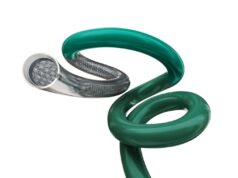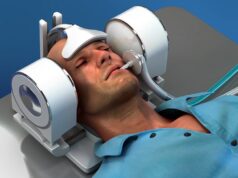
Peter Hamlyn’s career has extended into many specialties including neuro and spinal surgery and sports medicine. He was on the advisory panel for the London 2012 Olympic bid and was responsible for the treatment of eminent boxer Michael Watson. He, alongside Sid Watkins, who is widely recognised as the father of medicine provision in Formula One, established sports and exercise provision across all sports in the UK. His current work is focused on concussion in sport and the spine. He spoke to NeuroNews about how he became medical advisor to many of the top athletes and sporting bodies in the UK, winning the Whitechapel open and his interests outside of medicine
What drew you to medicine and neurosurgery?
What drew me to medicine was that I fancied being called Dr Hamlyn! Hopeless, I know. I was at college doing my A levels in physics, chemistry and mathematics and was not inspired by those. I was all for going out to work. My tutor said to me: “It would be such a pity if you did not give it a go—you could go anywhere and study anything… You could even get into medical school”, and so the seed was sown.
For neurosurgery, again, it was luck. I became inspired by the brain and how it worked. University College London (UCL) then housed the world’s leading neuroscientists and several Nobel Prize winners and fellows of the Royal Society such as JZ Young, Sir Bernard Katz, Pat Wall, Sami Zeki, and Geof Burnstock. These were my daily tutors. I also took a year out to do an intercalated BSc in neuroscience, for which I received first class honours.
I went back to my medical studies with something of a heavy heart. I became heavily involved in art and won a few open competitions including the Whitechapel in 1982. I decided to stay in London and took a rather hopeless ears, nose and throat (ENT) house job—arguably the worst house job you could get. The boss man, a wonderful man called Graham Fraser, showed me how to take out tonsils. A little boy described to me the torment of sore throats, and afterwards, he had “his problem” in a pickling jar courtesy of yours truly. I was hooked.
Having pursued ENT for a few years I got a job on the Head and Neck Unit of the Royal Marsden. Heavy cancer work directed me into doing some neurosurgery. They told me of the unit at The Royal London Hospital where Professor Sid Watkins ran a very busy show. I wrote to him and he interviewed me between cases and signed me up!
My first patient there was Richard, a school boy crippled by an appalling condition called dystonia musculoram deformans. He had been crushed in the space of a year from being a first-team rugby-playing academic into someone who was bed-bound, tube-fed and in catheterised agony. His family had been told it was untreatable and fatal. They had come to “The Prof” [Watkins] as a last hope; he was then doing a new kind of functional surgery with deep brain electrodes. Over the course of six months and a series of stereotactic surgeries, Richard returned to walking, school and laughter. I gave up art and became, for the next four years, a neurosurgical monk—eating, breathing and thinking of little else.
What inspired your interest in sport and exercise medicine?
Within neurosurgery, the spine always got a raw deal. The drama and attention was in the brain and yet the disability caused by spinal disorders can be awful. I saw that those patients deserved better. Spinal cord injury offers, perhaps, our brightest hope of securing meaningful advances in neuroprotection and neuro-regeneration. At the same time that I was heading in the direction of spinal surgery, I was also witnessing the other half of Sid’s life in sport. In 25 years at the frontline of Formula One medicine, he had set the gold standard and led the way for safety in all sports. When I encountered Michael Watson, the world champion boxing contender, he was firmly in the jaws of death as a result not only from the blows of his opponent (Chris Eubank) but from poor medical provision. I wondered why boxing did not have the facilities as Formula One did.
I ended up on News Night with Jeremy Paxman and an ethics woman from the British Medical Association who was calling for a ban on boxing. I suggested we should ban bad medicine from sport and made several suggestions of how that could be done.
Kate Hoey, then the minister with Responsibility for Sport (1999–2001), asked me to join a ministerial working group in Safety and Medicine in Sport. I subsequently chaired the group. We laid a method of transferring the Formula One system to all sports. It led to my appointment as medical advisor to the 2012 Olympic bid which we won in 2005. With the bid came the need to found the specialty of sport and exercise medicine.
My role now is concentrated on spine and concussion where I provide specialist services to the elite, and weekend warrior alike in fields as varied as rugby, ballet, judo, horse racing, cricket and tennis.
Who were your mentors and what wisdom did they impart to you?
In neurosurgery it has to be Sid Watkins. He was a neurosurgical father, a friend and an educator. There are others: Tom King, arguably the greatest technician I have seen in a neurosurgical theatre; John Pickard, a professor from Cambridge who helped me launch the Brain and Spine Foundation; and John Currie and Fary Afshar, who showed me how to work hard (Fary once told me with absolute sincerity that a day without neurosurgery is a day lost).
Richard Caborn, a past minister with Responsibility for Sport (2001–2007) achieved recognition for sport and exercise medicine from the Department of Culture, Media and Sport, when so many before him had failed. Along with Sir Liam Donaldson, then the UK’s chief medical officer, Richard Budgett, chief medical officer to the British Orthopaedic Association, and Nick Weborn, the Paralympic chief medical officer.
Which innovations in neuro and spinal surgery have shaped your career?
In neurosurgery the greatest advances are in scanning; CT and more recently MRI. In spinal surgery there are three: keyhole/minimally invasive techniques; the artificial disc and in particular its second generation prosthetics; and most recently the development of true intra spinal endoscopic surgery. However, it is in spinal medicine that I believe we are about to see the greatest advances. Danish researchers are about to publish work which could alter the management of low back pain radically.
As your main interest is in sports injury, please could you describe your work with head injury in sport?
Michael Watson was the most memorable cranial case. He is an inspiration to so many, including me. Having been left horribly disabled by his sport and poor medicine he defied a level of disability that would break most men. He was the third boxer I had treated and all of them had a lucid interval between the last punch being landed and their collapse into coma. They were a high-risk group in that they were all championship fights and the outcomes were related to the quality and speed of their pre-hospital treatment. Their history had already been written by the action or inaction of those on the scene. This was 1991, a time when the boxing world and many other sports were 20 years behind Formula One, and we changed that.
We changed it not just for boxing but all sports. When the International Olympics Committee inspected our bid after the presentation by Sir Liam their first question was “Will the standards of medical care offered to injured athletes meet Formula One standards?” I heard myself saying “Sir, not only can we deliver them but we invented them, disseminated them, have taught them and trained people with them. Eight of your Olympic nations had their chief medical officers trained here, the home and source of Olympic medicine.”
Could you describe a memorable case?
Joe Worsley, the England and London Wasps player, at the end of his career had a three-level reconstruction of an utterly battered cervical spine. I had the honour of working with him throughout some of his most successful years. He had endured incredible pain that hounded him every day but he was never swayed by it. He had the surgery and had his first night’s sleep in comfort. Just about the politest man I have known. I used to think I had worked hard until I met Joe.
Sophia Warner, the sprinter, she was dead cert for gold in the 100 and 200 metres but the week before she developed prolapsed cervical disc with numbness and weakness affecting both the trunk and her arm. She competed in spite of horrendous pain and personal danger, narrowly missing her medals, just one of the many amazing tales of the Paralympics. She then reported her agonies and was soon in surgery. She is now fully restored but is without sponsorship. She intends to compete in Rio on her own. That will be a race worth watching!
I cannot help but include Tom Croft, England and Leicester Tigers player. He sustained a fracture dislocation at C6 with triceps involvement and a unilateral fracture of the adjacent level facet. He was insuppressible from the outset and his patience has returned an extraordinary talent to the world stage.
What is your proudest achievement in neurosurgery and neurological spinal surgery?
Telling Professor Sid Watkins that his young prodigy had just been appointed as a consultant neurological and spinal surgeon to Saint Bartholomew’s Hospital, Europe’s oldest hospital. Young is the operative word for I was then the youngest person to achieve the position. Sid had the chair at The Royal London (a long-term firm rival of Saint Bartholomew’s). With his Churchillian twinkle he announced the development was excellent and that “they have just appointed the least experienced neurosurgeon in Britain—wonderful!”
How do you see the neurosurgical field developing in the future?
Endoscopic surgery will become the standard for most lumbar discs; we will stop fusing spines and use medical therapies more than we do now. This is a simplification but I will eat my surgical hat if we look back in 10 years and find that these are not broadly true.
What are your interests outside of medicine?
My family, modern history and biography.
Fact File
Current positions
Director of Education and Development Institute of Sport, Exercise and Health, University College London, UK
Honorary consultant neurosurgeon, University College London Hospital, UK
Consultant neurological spinal surgeon, Princess Grace Hospital, London, UK
Acting chairman (as vice chairman) Brain and Spine Foundation, UK
Chairman Foundation for Human Potential
Director Broadgate Spine and Joint Clinic, UK
Previous appointments
2004–2005 Member of the 2012 Olympic Bid Advisory Panel
2003– 2007 Director of the Centre for Sport and Exercise Medicine, Queen Mary University
2002–June 2003 Chairman Ministerial Working Group on Medicine and Safety in Sport, Department of Culture Media and Sport
1991–2003 Consultant neurological and spinal surgeon to Saint Bartholomew’s and London NHS Trust, Queen Mary University, London The Royal
Correspondent for the Sports Section of The Daily Telegraph newspaper
Sports appointments
Medical Advisor (past and present) to:
The Society of British Neurological Surgeons
General Medical Council
Trigeminal Neuralgia Association of Great Britain
London 2012 Olympic bid
British Olympic Association
British Boxing Board of Control
The Jockey Club of Great Britain
UK Sport
The Royal Ballet
The GB rowing team
England Rugby premier league football and rugby clubs










